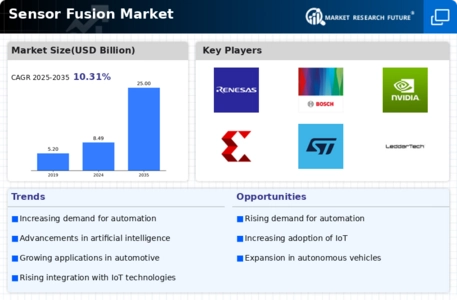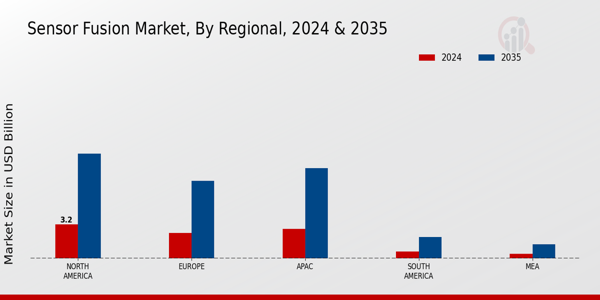Market Growth Projections
The Global Sensor Fusion Market Industry is poised for substantial growth, with projections indicating a market size of 8.49 USD Billion in 2024 and an anticipated increase to 25 USD Billion by 2035. This growth trajectory suggests a compound annual growth rate of 10.32% from 2025 to 2035. The expansion is driven by various factors, including advancements in technology, increasing demand across multiple sectors, and the integration of sensor fusion in emerging applications. The market's evolution reflects a broader trend towards data-driven decision-making and automation, highlighting the critical role of sensor fusion in shaping future technological landscapes.
Enhanced Consumer Electronics
The demand for sophisticated consumer electronics is a driving force in the Global Sensor Fusion Market Industry. As devices such as smartphones, wearables, and smart home products evolve, the integration of sensor fusion technologies becomes essential for improved functionality and user experience. For instance, smartphones utilize sensor fusion for features like augmented reality and advanced photography. This trend is likely to sustain market growth, as consumers increasingly seek devices that offer enhanced capabilities. The continuous innovation in consumer electronics suggests that sensor fusion will remain a critical component in meeting consumer expectations and driving market expansion.
Increased Focus on Smart Cities
The Global Sensor Fusion Market Industry is significantly impacted by the growing emphasis on smart city initiatives worldwide. Urban planners and governments are increasingly adopting sensor fusion technologies to enhance city management and improve public services. By integrating data from various sensors, cities can optimize traffic flow, monitor environmental conditions, and enhance public safety. This trend is expected to propel the market forward, as investments in smart infrastructure are projected to escalate. The anticipated market size of 25 USD Billion by 2035 underscores the potential of sensor fusion in transforming urban environments into more efficient and livable spaces.
Advancements in IoT Technologies
The proliferation of Internet of Things (IoT) devices significantly influences the Global Sensor Fusion Market Industry. As smart devices become increasingly interconnected, the need for effective data integration and analysis rises. Sensor fusion technologies facilitate the seamless amalgamation of data from various sources, enhancing decision-making processes across industries such as healthcare, agriculture, and smart cities. This trend is expected to contribute to the market's growth, with projections indicating a compound annual growth rate of 10.32% from 2025 to 2035. The ability to harness real-time data through sensor fusion is likely to drive innovation and efficiency in numerous applications.
Growing Applications in Healthcare
The Global Sensor Fusion Market Industry is witnessing a burgeoning interest in healthcare applications, where sensor fusion technologies are utilized for patient monitoring and diagnostics. By integrating data from various medical sensors, healthcare providers can achieve more accurate and timely assessments of patient conditions. This trend is particularly relevant in telemedicine and remote patient monitoring, where real-time data is crucial. The increasing adoption of wearable health devices further underscores the importance of sensor fusion in healthcare. As the industry evolves, the potential for sensor fusion to enhance patient care and operational efficiency appears promising.
Rising Demand for Autonomous Vehicles
The Global Sensor Fusion Market Industry experiences a notable surge in demand driven by the automotive sector's shift towards autonomous vehicles. As manufacturers integrate advanced sensor technologies, including LiDAR, radar, and cameras, the market is projected to reach 8.49 USD Billion in 2024. This integration enhances vehicle safety and navigation capabilities, thereby appealing to consumers and regulatory bodies alike. The anticipated growth in this sector is indicative of a broader trend towards automation in transportation, suggesting that sensor fusion technologies will play a pivotal role in shaping the future of mobility.

























Leave a Comment